Sn1 solvolysis - Study guides, Class notes & Summaries
Looking for the best study guides, study notes and summaries about Sn1 solvolysis? On this page you'll find 9 study documents about Sn1 solvolysis.
All 9 results
Sort by
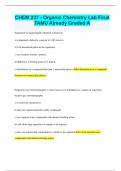
-
CHEM 237 - Organic Chemistry Lab Final TAMU Already Graded A
- Exam (elaborations) • 20 pages • 2023
- Available in package deal
-
- $9.99
- + learn more
CHEM 237 - Organic Chemistry Lab Final TAMU Already Graded A Separation by liquid-liquid extraction is based on a) compound's dielectric constant in 2 dif solvents b) # of theoretical plates in the separation c) use of phase transfer catalysts d) difference in boiling points of 2 liquids e) distribution of a compound between 2 immiscible phases e) Distribution of a compound between two immiscible phases. Preparative gas chromatography is often chosen over distillation as a means of separa...
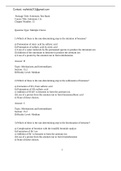
-
Package Title: Solomons Test Bank Course Title: Solomons 11e Chapter Number: 15
- Exam (elaborations) • 119 pages • 2022
-
- $10.89
- + learn more
Package Title: Solomons Test Bank Course Title: Solomons 11e Chapter Number: 15 Question Type: Multiple Choice 1) Which of these is the rate-determining step in the nitration of benzene? a) Protonation of nitric acid by sulfuric acid b) Protonation of sulfuric acid by nitric acid c) Loss of a water molecule by the protonated species to produce the nitronium ion d) Addition of the nitronium to benzene to produce the arenium ion e) Loss of a proton by the arenium ion to form nitrobenzene Answer: D...
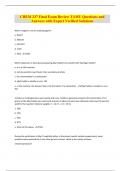
-
CHEM 237 Final Exam Review TAMU Questions and Answers with Expert Verified Solutions
- Exam (elaborations) • 29 pages • 2024
-
- $9.99
- + learn more
CHEM 237 Final Exam Review TAMU Questions and Answers with Expert Verified Solutions Which reagent is not an oxidizing agent? a. NaOCl b. KMnO4 c. K2Cr2O7 d. CrO3 e. H2O - H2O Which statement is false about preparing alkyl halide from alcohol with hydrogen halide? a. it is an SN1 reaction b. tertiary alcohols react faster than secondary alcohols c. the intermediate is a carbocation d. alkyl halide is soluble in conc. HCl e. in the reaction, the slowest step is the formation of a ca...
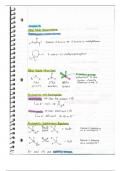
-
Organic Chemistry Chapter 7 Part 1 Notes - App State CHE 2201
- Class notes • 7 pages • 2023
- Available in package deal
-
- $5.99
- + learn more
Part 1 of Chapter 7 of Organic Chemistry 1 at App State (CHE2201) taught by Dr. Moeller. This chapter is very long so it is split into two parts. The first part of this chapter covers alkyl halide nomenclature, nucleophiles, substitution reactions (SN1 and SN2), reaction rates, leaving groups, solvents, and solvolysis. Some images/definitions are not entirely my own; credit for any work that is not mine goes to its rightful owners.
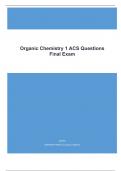
-
Organic Chemistry 1 ACS Questions Final Exam
- Exam (elaborations) • 16 pages • 2024
-
- $12.49
- + learn more
sp, linear - Correct Answers: Which is the correct hybridization state and geometry for the carbon atom in HCN? sp, linear sp2, trigonal planar sp3, tetrahedral None of the above This structure has one positive charge and one negative charge. - Correct Answers: The following structure has been drawn without formal charges. Which statement describes the missing formal charge(s)? This structure has one positive charge and one negative charge. This structure has one positive charge bu...

-
CHEMISTRY 2020 Experiment 4: Kinetics of Nucleophilic Substitutions
- Exam (elaborations) • 6 pages • 2023
-
- $10.99
- + learn more
CHEMISTRY 2020 Experiment 4: Kinetics of Nucleophilic Substitutions Chetna Raj June 14th, 2016 Chemistry 2020 Lab 3 Results 1. Determine the effect of varying [OH-] on the rate of the reaction. To do this, you should complete the following table: Table 1: Reaction Rates in Variations of [OH-] Experiment [tBuCl] (M) [OH-] (M) Reaction Time (s) Reaction Rate (M/s) Rate Constant k (s-1) 1 0.03 0.003 44 7.18 × 10-5 2.39 × 10-3 2 0.03 0.006 106 6.32 × 10-5 ...

-
CHEMISTRY 2020 Experiment 4: Kinetics of Nucleophilic Substitutions
- Exam (elaborations) • 6 pages • 2022
-
- $14.49
- + learn more
CHEMISTRY 2020 Experiment 4: Kinetics of Nucleophilic Substitutions Chetna Raj June 14th, 2016 Chemistry 2020 Lab 3 Results 1. Determine the effect of varying [OH-] on the rate of the reaction. To do this, you should complete the following table: Table 1: Reaction Rates in Variations of [OH-] Experiment [tBuCl] (M) [OH-] (M) Reaction Time (s) Reaction Rate (M/s) Rate Constant k (s-1) 1 0.03 0.003 44 7.18 × 10-5 2.39 × 10-3 2 0.03 0.006 106 6.32 × 10-5 ...

-
CHEMISTRY 2020 Experiment 4: Kinetics of Nucleophilic Substitutions
- Exam (elaborations) • 6 pages • 2022
-
- $14.49
- + learn more
CHEMISTRY 2020 Experiment 4: Kinetics of Nucleophilic Substitutions Chetna Raj June 14th, 2016 Chemistry 2020 Lab 3 Results 1. Determine the effect of varying [OH-] on the rate of the reaction. To do this, you should complete the following table: Table 1: Reaction Rates in Variations of [OH-] Experiment [tBuCl] (M) [OH-] (M) Reaction Time (s) Reaction Rate (M/s) Rate Constant k (s-1) 1 0.03 0.003 44 7.18 × 10-5 2.39 × 10-3 2 0.03 0.006 106 6.32 × 10-5 ...
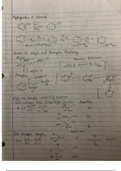
-
Organic Chemistry Notes: Allylic and Benzylic Reactivity
- Class notes • 7 pages • 2021
- Available in package deal
-
- $5.49
- + learn more
In depth notes with chemical reactions, diagrams and mechanisms and their breakdowns.

Study stress? For sellers on Stuvia, these are actually golden times. KA-CHING! Earn from your study resources too and start uploading now. Discover all about earning on Stuvia


